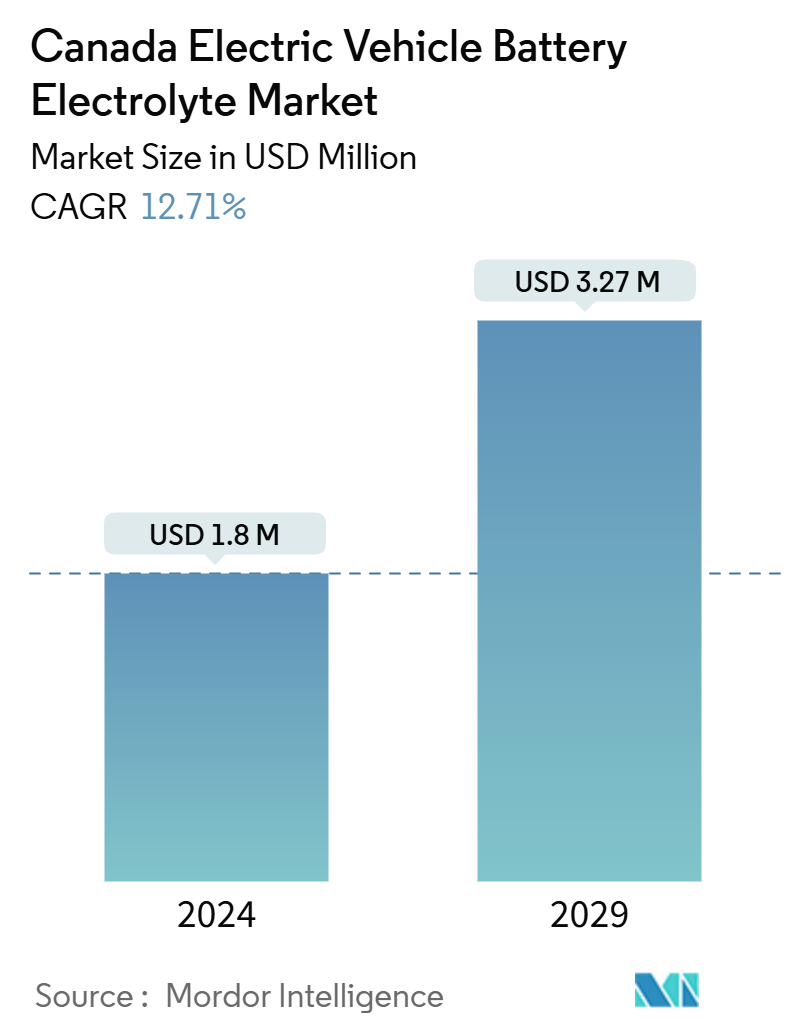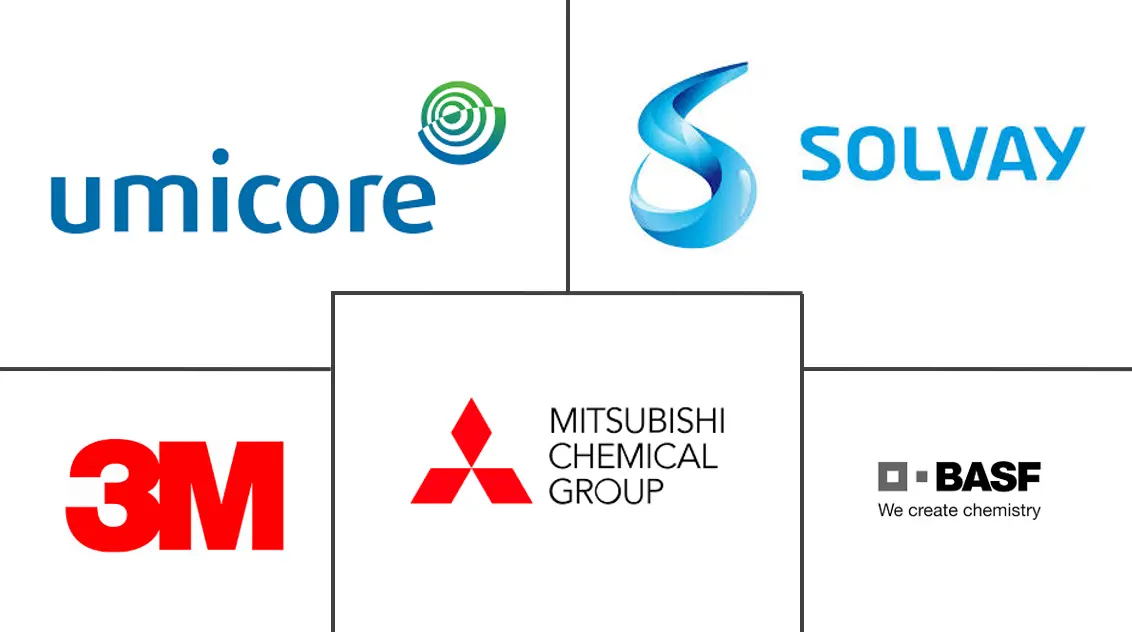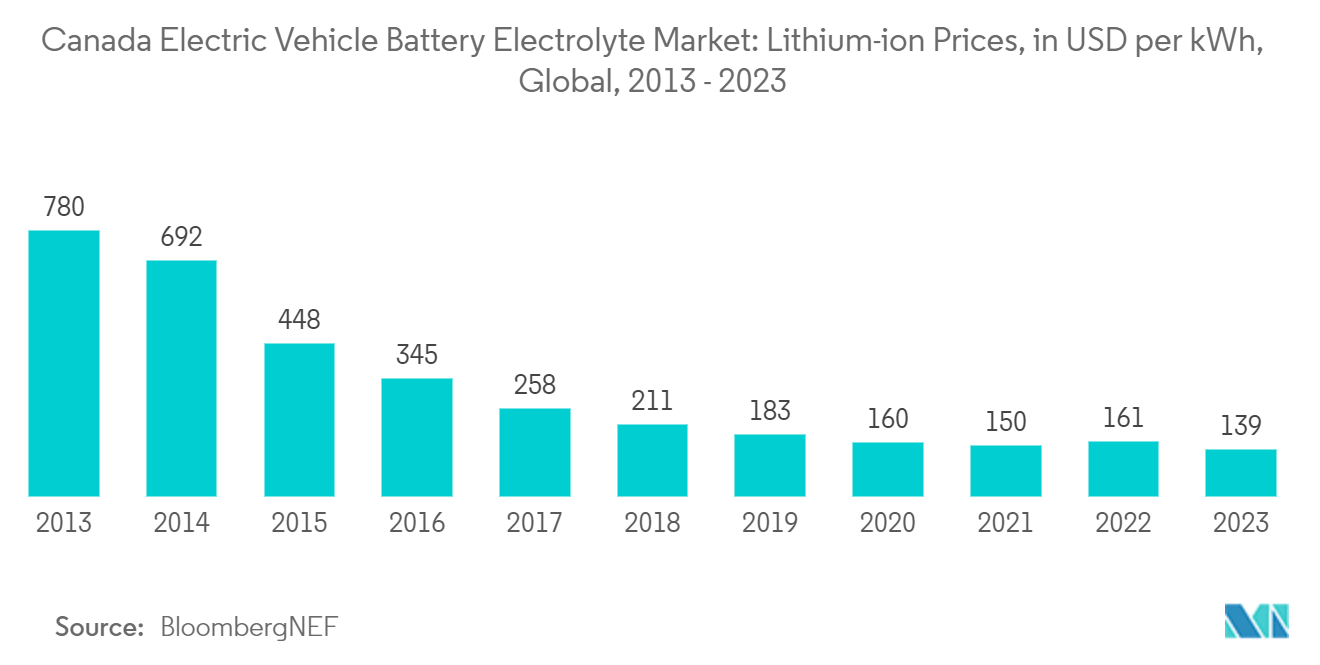Canada Electric Vehicle Battery Electrolyte Market Size

| Study Period | 2019 - 2029 |
| Base Year For Estimation | 2023 |
| Market Size (2024) | USD 1.8 Million |
| Market Size (2029) | USD 3.27 Million |
| CAGR (2024 - 2029) | 12.71 % |
| Market Concentration | High |
Major Players
*Disclaimer: Major Players sorted in no particular order |
Canada Electric Vehicle Battery Electrolyte Market Analysis
The Canada Electric Vehicle Battery Electrolyte Market size is estimated at USD 1.8 million in 2024, and is expected to reach USD 3.27 million by 2029, at a CAGR of 12.71% during the forecast period (2024-2029).
- Over the medium term, factors such as the rising electric vehicle (EV) adoption and suppotive government initiatives are expected to drive the market during the forecast period.
- On the other hand, supply chain disruptions are likely to hinder market growth during the forecast period.
- Nevertheless, innovations in electrolyte formulations are expected to provide significant opportunities for the market in the coming years.
Canada Electric Vehicle Battery Electrolyte Market Trends
Rising Electric Vehicle (EV) Adoption
- In recent years, both federal and provincial levels of the Canadian government have made significant strides in outlining and supporting actions against climate change. Under the Paris Climate Agreement, the federal government has committed to reducing greenhouse gas (GHG) emissions by 30% from 2005 levels by 2030. This translates to a reduction of 200 to 300 megatons from projected emission levels.
- Given that the transportation sector ranks as Canada's second-largest GHG emitter, the widespread adoption of electric vehicle (EV) technology offers a substantial opportunity for provinces and territories to meet their GHG reduction targets. Provinces like British Columbia, Quebec, and Ontario are at the forefront, championing EV adoption.
- Canada aims for 100% of vehicle sales to be zero-emission by 2035, with both federal and provincial governments playing pivotal roles in this transition. As the government actively promotes electric vehicles, this push is anticipated to bolster domestic demand. Consequently, this surge in demand is likely to elevate the need for battery electrolytes within Canada.
- Data from the Canada Energy Regulator highlights a surge in electric vehicle (EV) sales across the nation. In 2023, Canada registered 139,521 battery electric vehicles, marking a 41% increase from 2022's 98,589. To put this in perspective, 2019 saw 56,165 registrations (2.9% of total), and 2017 had 19,696 (1% of total).
- The Canadian automotive landscape is undergoing a transformation, with many manufacturers shifting focus towards electrification. This shift is evident as they either establish new plants or repurpose existing ones for EV production.
- For example, in January 2024, Honda Motor Co. unveiled plans for a USD 13.83 billion electric vehicle factory in Canada, which will also feature in-house battery production. Honda is eyeing multiple potential sites, notably one next to its current Ontario factory. A decision is expected by the close of 2024, with operations slated to commence by 2028.
- Given the rising EV manufacturing and the uptick in light electric vehicle adoption, there's a burgeoning demand for EV batteries. This trend is poised to catalyze the growth of the battery electrolyte market in Canada during the forecast period.

Lithium-Ion Batteries Segment to Dominate the Market
- In Canada, the lithium-ion battery segment stands as a pivotal player in the electric vehicle (EV) battery electrolyte market, propelled by the swift uptake of electric vehicles and breakthroughs in battery technology.
- With the Canadian government championing greener transportation and a growing consumer preference for EVs, the appetite for efficient, high-performance batteries is on the rise. In this landscape, electrolytes play a vital role, bolstering battery performance, safety, and longevity.
- A key driver behind the lithium-ion battery segment's expansion is the marked decline in battery costs. For example, in 2023, the average price of lithium-ion batteries dipped to approximately USD 139 per kilowatt-hour (kWh), showcasing a remarkable drop of over 82% since 2013. Forecasts suggest prices might plummet to below USD 113/kWh by 2025 and could touch USD 80/kWh by 2030.
- This downward trajectory in battery prices not only broadens the accessibility of electric vehicles for consumers but also spurs manufacturers to channel investments into cutting-edge battery technologies and premium electrolytes, amplifying market demand.
- Moreover, sustainability is emerging as a pivotal force in the lithium-ion battery segment. With a surge in environmental consciousness, manufacturers are pivoting towards eco-friendly electrolyte solutions crafted from sustainable materials. This green shift not only resonates with consumer preferences but also dovetails with regulatory mandates aimed at curbing the environmental footprint of battery production.
- In April 2024, Asahi Kesai unveiled plans for a lithium-ion battery component manufacturing plant. With a hefty investment of around USD 1.3 billion, the facility is poised to complement Honda's EV operations in the nation. Such strategic investments bolster the lithium-ion battery landscape in Canada.
- In summary, as the market landscape transforms, the clamor for high-performance electrolytes is set to intensify, spurring innovation and propelling the broader electric vehicle sector's growth in Canada.

Canada Electric Vehicle Battery Electrolyte Industry Overview
The Canada electric vehicle battery electrolyte market is semi-consolidated. Some of the major players include (not in particular order) Mitsubishi Chemical Group, 3M, Umicore N.V, Solvay SA, and BASF SE, among others.
Canada Electric Vehicle Battery Electrolyte Market Leaders
-
Mitsubishi Chemical Group
-
3M
-
Solvay SA
-
BASF SE
-
Umicore N.V
*Disclaimer: Major Players sorted in no particular order

Canada Electric Vehicle Battery Electrolyte Market News
- September 2023: Northvolt, a Swedish producer of lithium-ion batteries, has unveiled plans to invest USD 5.2 billion in a gigafactory located in Quebec. The project's initial phase, with a total investment of USD 7 billion, aims for an annual battery cell manufacturing capacity of up to 30 GWh. Construction of the Northvolt Six factory's first phase is slated to commence operations in 2026.
- November 2023: E-One Moli Energy has selected a community in British Columbia's Lower Mainland to establish a new lithium-ion battery cell manufacturing plant, with an investment of USD 1.05 billion. Located in Maple Ridge, a northeastern area of Greater Vancouver, the plant's expansion is bolstered by a combined federal-provincial investment of USD 280 million.
Canada Electric Vehicle Battery Electrolyte Market Report - Table of Contents
1. INTRODUCTION
1.1 Scope of Study
1.2 Market Definition
1.3 Study Assumptions
2. RESEARCH METHODOLOGY
3. EXECUTIVE SUMMARY
4. MARKET OVERVIEW
4.1 Introduction
4.2 Market Size and Demand Forecast in USD, till 2029
4.3 Recent Trends and Developments
4.4 Government Policies and Regulations
4.5 Market Dynamics
4.5.1 Drivers
4.5.1.1 Rising Electric Vehicle (EV) Adoption
4.5.1.2 Supportive Government Initiatives
4.5.2 Restraints
4.5.2.1 Supply Chain Disruptions
4.6 Supply Chain Analysis
4.7 PESTLE Analysis
4.8 Investment Analysis
5. MARKET SEGMENTATION
5.1 Battery Type
5.1.1 Lithium-Ion Batteries
5.1.2 Lead-Acid Batteries
5.1.3 Others
5.2 Electrolyte Type
5.2.1 Liquid Electrolyte
5.2.2 Gel Electrolyte
5.2.3 Solid Electrolyte
6. COMPETITIVE LANDSCAPE
6.1 Mergers and Acquisitions, Joint Ventures, Collaborations, and Agreements
6.2 Strategies Adopted by Leading Players
6.3 Company Profiles
6.3.1 Mitsubishi Chemical Group
6.3.2 3M
6.3.3 Ilika plc
6.3.4 W. L. Gore & Associates, Inc
6.3.5 Echion Technologies
6.3.6 BASF SE
6.3.7 Solvay SA
6.3.8 Hitachi, Ltd.
6.3.9 Cabot Corporation
6.3.10 Umicore N.V
- *List Not Exhaustive
6.4 Market Ranking/Share Analysis
6.5 List of Other Prominent Companies
7. MARKET OPPORTUNITIES AND FUTURE TRENDS
7.1 Innovations in Electrolyte Formulations
Canada Electric Vehicle Battery Electrolyte Industry Segmentation
An electric vehicle (EV) battery electrolyte is a substance that facilitates the movement of ions between the positive and negative electrodes within a battery, enabling the flow of electrical current. In lithium-ion batteries, commonly used in EVs, the electrolyte is typically a liquid or gel composed of lithium salts dissolved in an organic solvent. This electrolyte is crucial for the battery's operation, affecting its efficiency, lifespan, and safety.
The Canadian electric vehicle battery electrolyte market is segmented by battery type, electrolyte type, and geography. By battery type, it is divided into lithium-ion batteries, lead-acid batteries, and others. By electrolyte type, it is divided into liquid electrolytes, gel electrolytes, and solid electrolytes.
For each segment, the market sizing and forecasts have been done based on market size in USD.
| Battery Type | |
| Lithium-Ion Batteries | |
| Lead-Acid Batteries | |
| Others |
| Electrolyte Type | |
| Liquid Electrolyte | |
| Gel Electrolyte | |
| Solid Electrolyte |
Canada Electric Vehicle Battery Electrolyte Market Research Faqs
How big is the Canada Electric Vehicle Battery Electrolyte Market?
The Canada Electric Vehicle Battery Electrolyte Market size is expected to reach USD 1.8 million in 2024 and grow at a CAGR of 12.71% to reach USD 3.27 million by 2029.
What is the current Canada Electric Vehicle Battery Electrolyte Market size?
In 2024, the Canada Electric Vehicle Battery Electrolyte Market size is expected to reach USD 1.8 million.
Who are the key players in Canada Electric Vehicle Battery Electrolyte Market?
Mitsubishi Chemical Group, 3M, Solvay SA, BASF SE and Umicore N.V are the major companies operating in the Canada Electric Vehicle Battery Electrolyte Market.
What years does this Canada Electric Vehicle Battery Electrolyte Market cover, and what was the market size in 2023?
In 2023, the Canada Electric Vehicle Battery Electrolyte Market size was estimated at USD 1.57 million. The report covers the Canada Electric Vehicle Battery Electrolyte Market historical market size for years: 2019, 2020, 2021, 2022 and 2023. The report also forecasts the Canada Electric Vehicle Battery Electrolyte Market size for years: 2024, 2025, 2026, 2027, 2028 and 2029.
Canada Electric Vehicle Battery Electrolyte Industry Report
Statistics for the 2024 Canada Electric Vehicle Battery Electrolyte market share, size and revenue growth rate, created by Mordor Intelligence™ Industry Reports. Canada Electric Vehicle Battery Electrolyte analysis includes a market forecast outlook for 2024 to 2029 and historical overview. Get a sample of this industry analysis as a free report PDF download.

